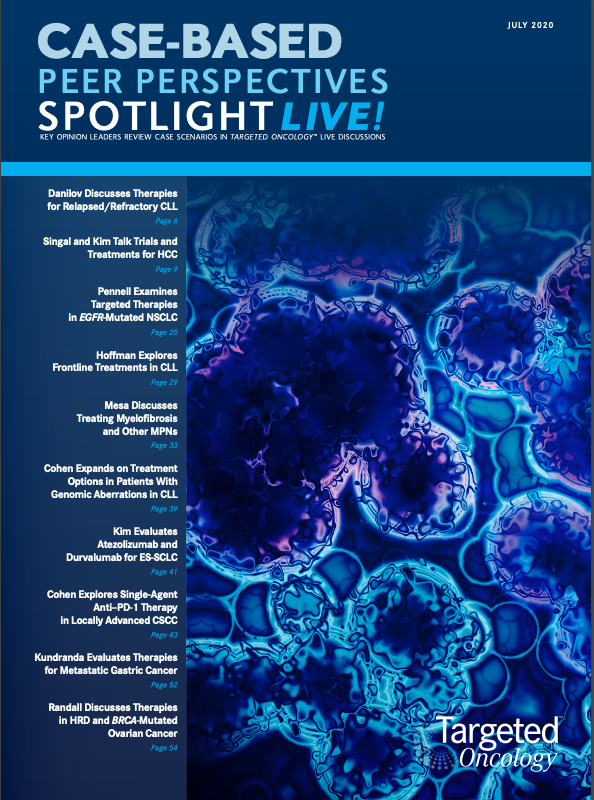Kundranda Evaluates Therapies for Metastatic Gastric Cancer
During a virtual Case Based Peer Perspectives series, Madappa Kundranda, MD, PhD, discussed the case of a 60-year-old male patient diagnosed with poorly differentiated gastric adenocarinoma.
Madappa Kundranda, MD, PhD

During a virtual Case Based Peer Perspectives series, Madappa Kundranda, MD, PhD, gastrointestinal medical oncologist, Banner ND Anderson, Cancer Center Clinic, discussed the case of a 60-year-old male patient diagnosed with poorly differentiated gastric adenocarinoma.
Targeted Oncology™: Do you agree with the therapy this patient was given?
KUNDRANDA: What’s interesting is when you look at the NCCN [National Comprehensive Cancer Center] guidelines, they still talk about the triplet.1 I think this is something that tends to be archaic. I don’t think any of us at this point in time use an epirubicin-based therapy based on the data that were presented [in this setting], which compared epirubicin combination triplet with FOLFIRI [folinic acid, 5-fluorouracil (5-FU), and irinotecan] and did not show any improvement in survival. If anything, there were additional toxicities.2
Typically, now we use FLOT [docetaxel, oxaliplatin, leucovorin, and 5-FU] in the perioperative setting. We also use DCF [docetaxel, cisplatin, and 5-FU], but we use the modified form of it. In Europe, they use a lot more cisplatin and oxaliplatin, but I think FOLFOX [folinic acid, 5-FU, and oxaliplatin] and CAPOX are decent combinations to start off with.
With regard to HER2/neu amplification, unlike with breast cancer…trastuzumab [Herceptin] continued beyond first-line progression is not something that we do. It’s something that we have data for, which do not support continuing on with the HER2/neu therapy beyond progression, especially after the frontline setting.
What do you think of the patient’s second-line treatment? What is the most important thing that you’re looking for while you’re choosing this regimen?
As you would see with most patients, 6 months later he ends up having imaging scans, which demonstrate progression of the lung. He has a CPS score of 5%; his tumor is non-HER2/neu amplified.
We know about 50% of these patients fall off [therapy] going from the front line to the second line. As medical oncologists, we look at a survival benefit. What are we trying to achieve in the second line with patients after frontline fluoropyrimidine-based therapy with a platinum [chemotherapy]? The quality of life [score for] most of these patients is ECOG 1 bordering on ECOG 2; few are ECOG 0 at that point in time.
If you’re looking at this as a gastroesophageal junction versus a gastric tumor, do you treat them any differently?
I think, to a certain extent, we’re histologically or molecularly starting to classify gastric tumors into different subsets. However, we still haven’t had any luck in the context of switching therapies and treating them differently; we still treat them as the same entity. I’m not sure whether that’s the right thing or not.
When we look at the Epstein-Barr virus status, BRCA status, and the microsatellite instability status, these [characteristics] tend to behave differently in gastric cancer, and I think that’s where the field is shifting in the context of it.
At this point in time, we’re not looking at it differently. I think that’s where the future trials will be focused, in the context of molecularly subclassifying tumors and then treating appropriately, and then [seeing] what kind of a signal we have with the treatment options.
Are there clinical data to support the use of ramucirumab in this setting?
The RAINBOW study [NCT01170663] examined the use of paclitaxel plus or minus ramucirumab.3
This was a positive study and changed the whole paradigm. This trial was [initiated] before availability of immunotherapies, so it changed the landscape in the context of patients who have a good performance status. Those with a performance status that wasn’t pristine [could be] considered for treatment with ramucirumab alone.
But after all that, when we looked at the responses, the disease control rate [DCR] with this combination was about 80% versus with paclitaxel alone, which was about 65%. DCR was defined as a combination of complete response, partial response, and stable disease.
The toxicities of using this combination were higher than with paclitaxel alone. The standard toxicities are abdominal pain, hematological toxicities, fatigue—which I think most of us see. In our clinical practice, if patients don’t tolerate the 8 mg of paclitaxel, we skip it and go on a biweekly schedule.
How does pembrolizumab (Keytruda) play a role in this setting?
The KEYNOTE-059 study [NCT02335411] had 3 arms.4 One was the first cohort, which looked at patients who had more than 2 prior lines of therapy [and who were treated with pembrolizumab monotherapy]. The second arm [looked] at the subgroup of patients receiving frontline therapy with cisplatin plus 5-FU or capecitabine in combination with pembrolizumab. The third cohort was patients with no prior lines of therapy who had PD-L1–positive [tumors who were treated with pembrolizumab monotherapy].
One of the interesting things was that there seemed to be more responses in the patients with the CPS. Even the ones without a positive CPS tended to have a response.
One thing that we’ve realized in these patients—especially in patients who have received about 2 lines of therapy—is the ones [who] have the best response are the ones with the high CPS. I’ve been asked questions [about] patients who are microsatellite stable, but they have a CPS score of 50%. What do you do with these patients? Do you treat them [with immunotherapy] in the front line? I think that’s an unanswered question, and a couple of trials are looking at this.
The other question that’s most commonly asked is in a patient with a high tumor mutational burden, do you put these patients on checkpoint inhibitors? It’s something that we’ve been looking at, but not something that we are using as a standard of care at this time at least.
Are there data that do not include the patients’ CPS scores?
Unselected patients, those not influenced by CPS scores, [were treated on] a phase 1/2 trial of nivolumab [Opdivo]. Now that we know ramucirumab and paclitaxel are a second-line therapy and…immunotherapies are coming to the second line, investigators looked at this regimen in the context of moving it up and combining it with nivolumab.
These were patients who had a good performance status and had progressed on a platinum agent and fluoropyrimidine as frontline therapy. What’s interesting is that in these unselected patients, the progression-free survival was 5.1 months. Even at 18 months, the overall survival rate was roughly about a third of patients. There was a median survival of about 13 months.5
In the second line, when you look at median survival, it falls even with the ramucirumab and paclitaxel. When you look at this, the median survival of 13.1 is higher than what we’ve previously seen.
At this point, there is a signal that immunotherapies have a role in this setting. I think outside clinical trials, unless the patient has a high CPS in the front line, there is almost no role. In the second line, it’s still controversial, and I wouldn’t use it unless it’s on a clinical trial. In the third line [it’s an option], especially if it’s pembrolizumab for patients with a high CPS score.
References:
1. NCCN. Clinical Practice Guidelines in Oncology. Gastric cancer, version 2.2020. Accessed July 2, 2020. https://www.nccn.org/professionals/physician_gls/pdf/ gastric.pdf
2. Sendur MA, Ozdemir N, Özatlı T, et al. Comparison the efficacy of second-line modified EOX (epirubicin, oxaliplatin, and capecitabine) and irinotecan, 5-fluorouracil, and leucovorin (FOLFIRI) regimens in metastatic gastric cancer patients that progressed on first-line modified docetaxel and cisplatin plus fluorouracil (DCF) regimen. Med Oncol. 2014;31(9):153. doi:10.1007/s12032-014-0153-y
3. Wilke H, Muro K, Van Cutsem E, et al. Ramucirumab plus paclitaxel versus placebo plus paclitaxel in patients with previously treated advanced gastric or gastro-oesophageal junction adenocarcinoma (RAINBOW): a double-blind, randomised phase 3 trial. Lancet Oncol. 2014;15(11):1224-1235. doi:10.1016/S1470-2045(14)70420-6
4. Wainberg ZA, Jalal S, Muro K, et al. KEYNOTE-059 update: efficacy and safety of pembrolizumab alone or in combination with chemotherapy in patients with advanced gastric or gastroesophageal (G/GEJ) cancer. Ann Oncol. 2017;28(suppl 5):v616-v617. doi:10.1093/annonc/mdx440.220
5. Hironaka S, Kadowaki S, Izawa N, et al. A phase I/II study of nivolumab, paclitaxel, and ramucirumab as second-line in advanced gastric cancer. J Clin Oncol. 2020;38(suppl 4):352. doi:10.1200/JCO.2020.38.4_suppl.352

















